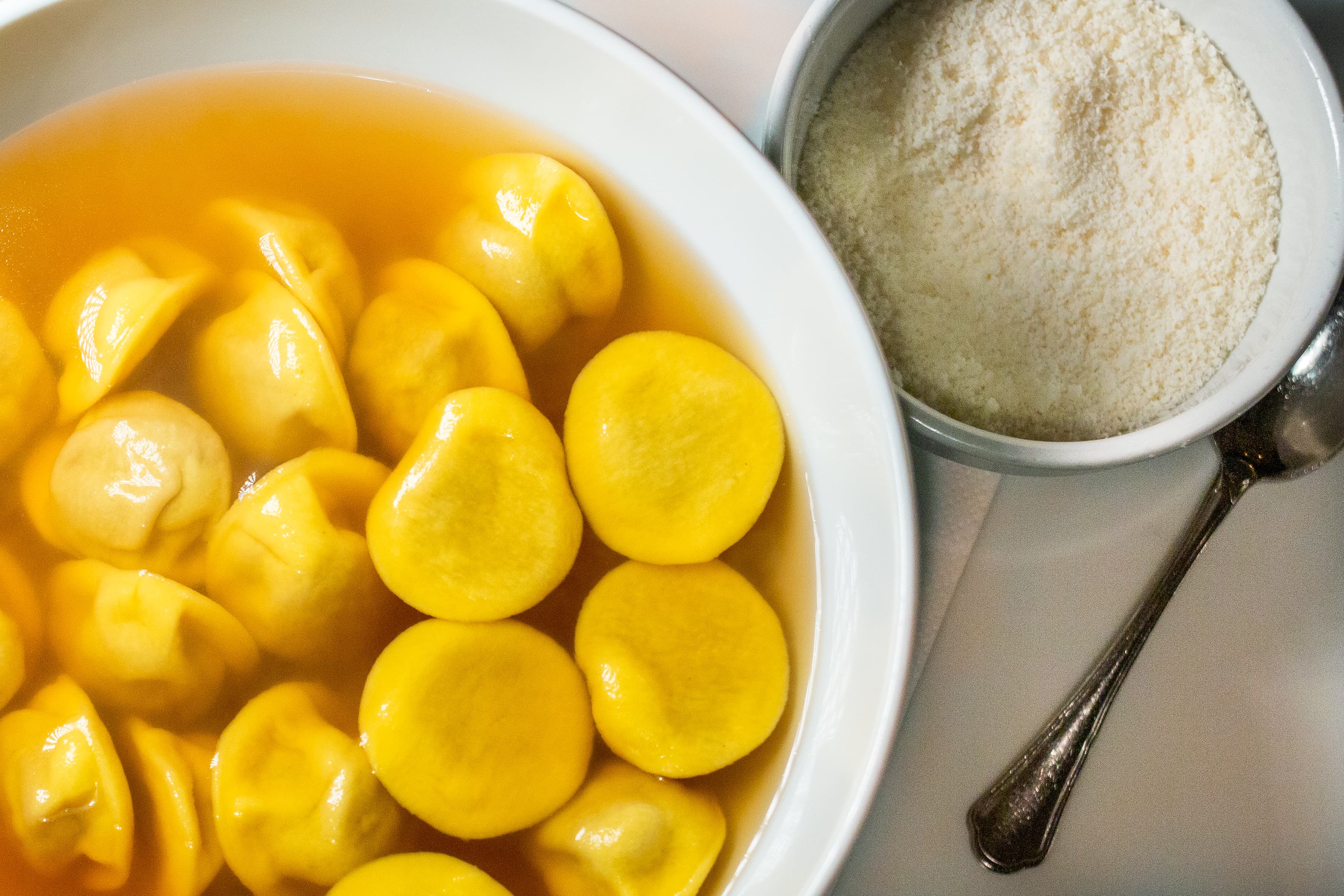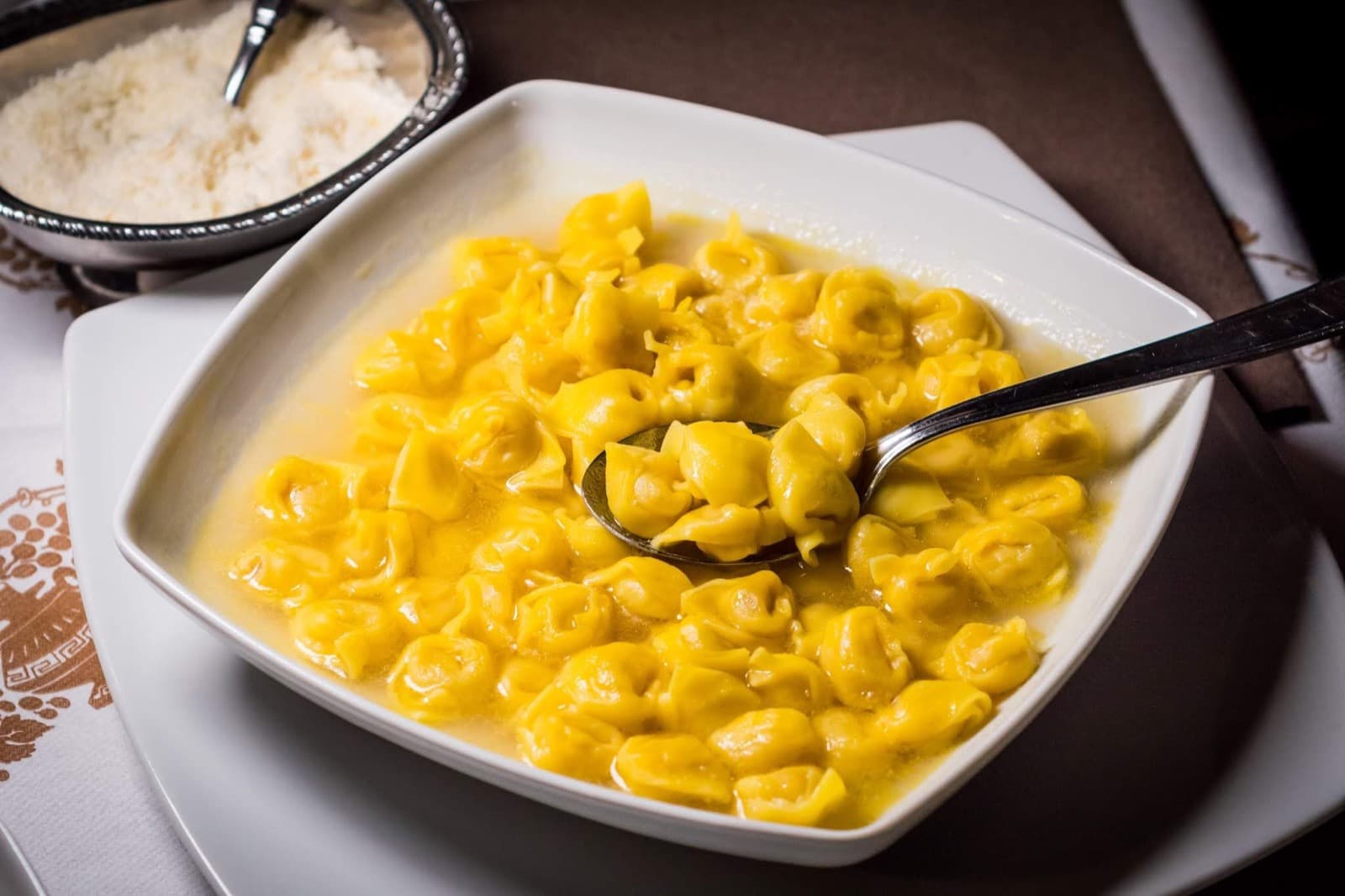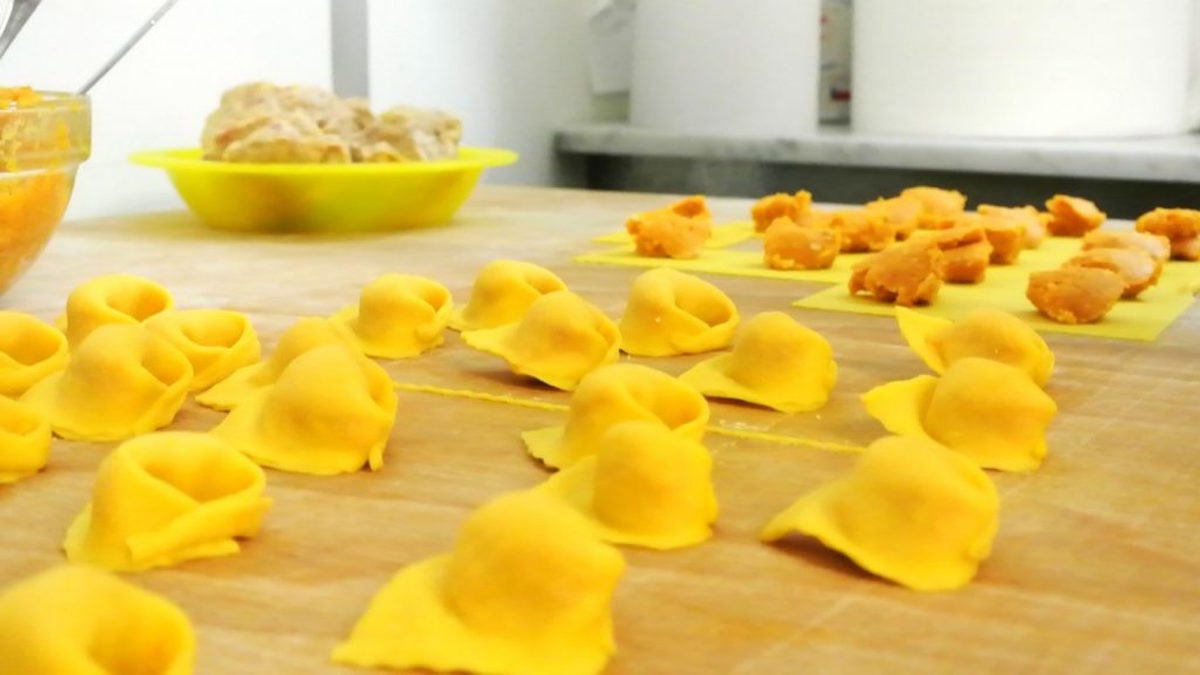Rich in history and flavors, the cuisine of Emilia-Romagna contains a galaxy of different culinary traditions. Each of its nine provinces includes a large variety of recipes characterized by raw ingredients of the highest quality and born of peasant knowledge lost in the history of this territory.
Tortellini, green tortelli or tortelli "con la coda" (with tail), anolini, cappelletti and cappellacci, garganelli, tagliatelle, lasagna, passatelli: stuffed or not, with a sauce or in broth, the greatest pride of Emilia-Romagna is egg pasta, made strictly by hand.
A few simple ingredients, such as eggs and flour, are enough to produce a long list of tasty and delicious first courses that differ in shape and/or type of filling.
The sauces also play a determining role in enriching the dishes by giving them a unique taste.
Ragù is certainly the most popular, even though its recipe can change depending on the area. However, traditional broth, strictly made from hen or capon, with its warm and hearty flavour is another well-liked option.
In Romagna, cappelletti, with their creamy Raviggiolo filling, are the absolute protagonist; tortellini, on the other hand, are a specialty of the Bologna and Modena area, with their typical meat-based filling.
The Ferrara area is renowned for its cappellacci, with a pumpkin filling, while in Parma/Piacenza area you cand find tortelli, stuffed with ricotta cheese and spinach.
However, the one and only staple of typical egg pasta in Emilia-Romagna are tagliatelle.
Pisarei and Fasò is a dish of ancient peasant tradition of the Piacenza area. They are hand-made gnocchi made with stale bread and flour and seasoned with a sauce made with beans, lard, onion and tomato.
It is said that the name Pisarei derives from the distortion of the Piacenza word bissa, meaning snake, due to the particular shape of the strips of pasta before being cut into "gnocchetti". However, it seems that the origin of the name could also be linked to the Spanish term pisar, to press.
Anolini is a type of filled pasta typical of the Emilia area, with very ancient origins that date back to the 12th century.
Its origin, claimed by both Parma and Piacenza, is at the center of a heated dispute between the two cities. Anolini is a dish usually served during festivities, such as Christmas. They are small round ravioli, filled with a mix of beef stew, Parmesan cheese, toasted bread and spices, and served in a tasty chicken or capon broth.
In the Piacenza variant anolini (in dialect "anvëin") are slightly smaller than the Parma ones. They have the shape of a crescent and are filled with either beef or pork stew. In the Parma area, on the other hand, they are round in shape, and jokingly nicknamed "lifebuoys". The filling is made with beef stew and Parmigiano-Reggiano.

Tortelli are one of the typical dishes of Emilia-Romagna, in particular of the areas around Parma, Piacenza and Reggio Emilia. Traditionally, they can have four different types of filling: spinach, potatoes, pumpkin or chestnuts.
Their origin seems to date back to the medieval period, when they were consumed instead of the traditionally meat-filled variant during the days when, according to Catholic tradition, meat was off limits.
Those filled with spinach (also called green tortelli) are still the best known and most representative of the area: an egg pasta with ricotta cheese and spinach or chard, served with melted butter, Parmesan cheese and a few spices (pepper or nutmeg).
An honorable mention goes to tortelli con la coda, an original and tasty variant of the “common” tortelli, typical of the municipality of Vigolzone, in the province of Piacenza.
Imperial soup is a typical dish of Emilia-Romagna, especially of the area around Bologna and Ravenna where it is served for lunch or dinner on important occasions.
Made with a mixture of semolina, eggs, grated Parmesan cheese, butter and nutmeg, it is baked in the oven first and then cut into squares and served in capon broth.
Tortellini are a true delicacy of Emilian cuisine. Cooked in beef and chicken broth, they are small but full of flavour, with their typical filling made with meat, Italian Prosciutto, mortadella and Parmigiano Reggiano.
For centuries, the two cities of Bologna and Modena have fought over this dish, claiming its origin. This, at least, until the end of the 19th century, when it was decided that the official birthplace of tortellini was Castelfranco Emilia, a town halfway between the two contenders, where the Festival of the traditional Tortellino is still held today in the second week of September.
In everyday life, each Emilian family has its own recipe, but there is also an "official" recipe, patented by the Dotta Confraternita del Tortellino at the Bologna Chamber of Commerce.

Green Bolognese lasagna is certainly the most representative dish of Italian cuisine abroad, well-known and loved all over the world.
Its origins are lost in time, but it is in Bologna that the recipe has been perfected and made into the staple that it is nowadays.
A sheet of fresh green egg pasta, cut in the shape of rectangles and layered with meat sauce, béchamel and parmesan cheese, is then baked in the oven until a crispy golden crust forms on top.
As with any traditional dish, there are many different variations of lasagna. However, the Italian Academy of Cuisine, after careful analysis, patented what can be considered the "original" recipe at the Bologna Chamber of Commerce.
Tagliatelle are an iconic dish of Emilia-Romagna, and another staple of Italian cuisine.
There are countless recipes that revolve around this kind of egg pasta, which can be enjoyed with many different sauces. Among these, the most famous is certainly Bolognese ragù, a great classic, served especially during Sunday lunches with family or friends.
The traditional Emilian recipe has been patented at the Bologna Chamber of Commerce in 1972, and it establishes the size of the pasta and the ingredients of the sauce. Every family has its own version although everyone agrees on two things: the minced meat for the sauce must be a mixture of pork and beef and it must be cooked slowly.
Cappellacci di Zucca IGP is a delicious dish typical of the Ferrara area. They are a kind of egg pasta with a luscious filling made with pumpkin pulp, Parmigiano Reggiano or Grana Padano, breadcrumbs, salt, pepper and a pinch of nutmeg.
This recipe has noble origins as it was born in the court of Alfonso II d'Este in the mid-16th century.
The peculiarity of the name (caplaz in dialect) recalls the traditional straw hats once worn by peasants.

Spoja lorda is an easy and tasty egg pasta dish typical of Emilia-Romagna.
Usually prepared during festivities or large family lunches, this kind of pasta appears as small squares with jagged edges, filled with ricotta and raviggiolo cheese (a typical cheese from the Tuscan-Romagna Apennines), eggs, Parmigiano Reggiano and a pinch of salt.
Depending on preference and availability, spoja lorda is usually served with a meat broth (capon or hen), but it also goes well with different sauces, such as white beef ragù.
Cappelletti (also called caplèt, is one of the traditional stuffed pasta of Romagna, served in borth or with ragù sauce especially during the Christmas holidays.
Similar to a tortellino but larger in size, this egg pasta is cut into squares, filled with cheese (ricotta, raviggiolo or casatella, parmesan cheese), and closed in the characteristic shape of a hat.
There are many existing variations and a lot of different opinions, both on how to close them and what to fill them with. In the Rimini area, for example, the filling is made with meat, while in the Ravenna-Cesena, they are filled with lean meat, herbs and cheeses.
Passatelli, made with eggs, breadcrumbs and Parmesan - as well as some lemon zest and a pinch of nutmeg - is one of the tastiest dishes of the Emilia-Romagna gastronomic tradition, mentioned by Artusi himself.
They look like small cylinders, or thick short spaghetti, and they are a quick and easy to prepare, using a specific tool called "iron for passatelli" or alternatively a potato masher with large holes.
They are usually cooked in meat or vegetable broths, but only for a few minutes, to prevent them from falling apart.
Basotti (also called bazòtt) are a typical dish of the Tuscan-Romagnolo Apennine area, in particular of the Alto Savio valley and the area of Bagno di Romagna.
To make basotti, tagliolini are cooked in a pork bone broth first, then layered inside a pan with lard, pecorino cheese and breadcrumbs and finally cooked on a grill.
Once the pasta has completely absorbed the broth, it is cut into squares of crunchy, delicious tagliolini.
If you are passionate about first courses, come and visit us, because there are many more to try:
In Piacenza and its province:
In Reggio Emilia and its province:
In Modena and its province:
In Bologna and its province: